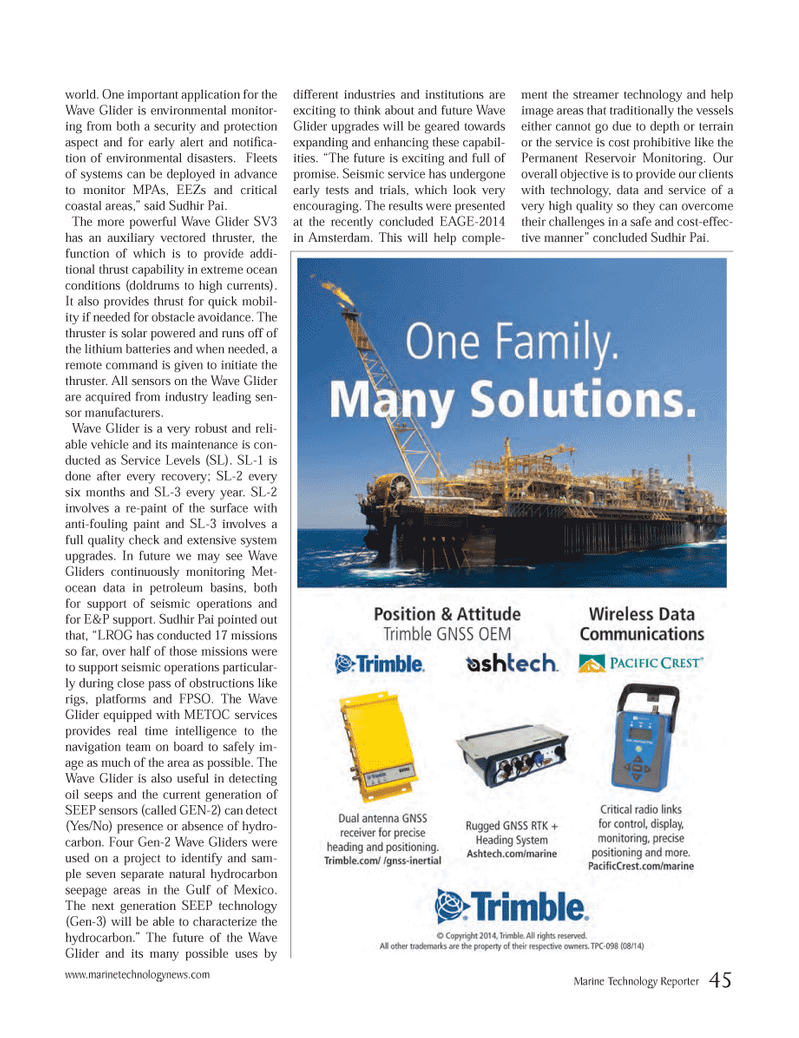
Page 45: of Marine Technology Magazine (September 2014)
Ocean Observation: Gliders, Buoys & Sub-Surface Networks
Read this page in Pdf, Flash or Html5 edition of September 2014 Marine Technology Magazine
world. One important application for the
Wave Glider is environmental monitor- ing from both a security and protection aspect and for early alert and notifi ca- tion of environmental disasters. Fleets of systems can be deployed in advance to monitor MPAs, EEZs and critical coastal areas,” said Sudhir Pai.
The more powerful Wave Glider SV3 has an auxiliary vectored thruster, the function of which is to provide addi- tional thrust capability in extreme ocean conditions (doldrums to high currents).
It also provides thrust for quick mobil- ity if needed for obstacle avoidance. The thruster is solar powered and runs off of the lithium batteries and when needed, a remote command is given to initiate the thruster. All sensors on the Wave Glider are acquired from industry leading sen- sor manufacturers.
Wave Glider is a very robust and reli- able vehicle and its maintenance is con- ducted as Service Levels (SL). SL-1 is done after every recovery; SL-2 every six months and SL-3 every year. SL-2 involves a re-paint of the surface with anti-fouling paint and SL-3 involves a full quality check and extensive system upgrades. In future we may see Wave
Gliders continuously monitoring Met- ocean data in petroleum basins, both for support of seismic operations and for E&P support. Sudhir Pai pointed out that, “LROG has conducted 17 missions so far, over half of those missions were to support seismic operations particular- ly during close pass of obstructions like rigs, platforms and FPSO. The Wave
Glider equipped with METOC services provides real time intelligence to the navigation team on board to safely im- age as much of the area as possible. The
Wave Glider is also useful in detecting oil seeps and the current generation of
SEEP sensors (called GEN-2) can detect (Yes/No) presence or absence of hydro- carbon. Four Gen-2 Wave Gliders were used on a project to identify and sam- ple seven separate natural hydrocarbon seepage areas in the Gulf of Mexico.
The next generation SEEP technology (Gen-3) will be able to characterize the hydrocarbon.” The future of the Wave
Glider and its many possible uses by different industries and institutions are exciting to think about and future Wave
Glider upgrades will be geared towards expanding and enhancing these capabil- ities. “The future is exciting and full of promise. Seismic service has undergone early tests and trials, which look very encouraging. The results were presented at the recently concluded EAGE-2014 in Amsterdam. This will help comple- ment the streamer technology and help image areas that traditionally the vessels either cannot go due to depth or terrain or the service is cost prohibitive like the
Permanent Reservoir Monitoring. Our overall objective is to provide our clients with technology, data and service of a very high quality so they can overcome their challenges in a safe and cost-effec- tive manner” concluded Sudhir Pai. www.marinetechnologynews.com
Marine Technology Reporter 45
MTR #7 (34-49).indd 45 8/27/2014 9:41:23 AM

 44
44

 46
46
